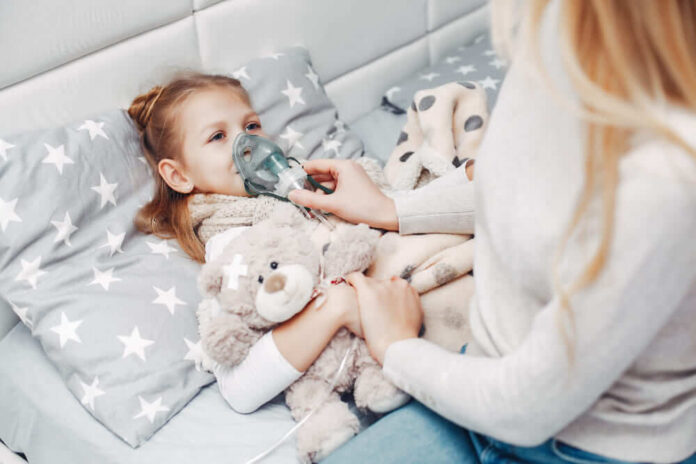Obstructive sleep apnea is significantly underdiagnosed in infants and children. Sleep apnea can cause physical issues, but it can also cause academic and behavioral issues. A diagnosis of obstructive sleep apnea requires a thorough and comprehensive history and physical assessment. So this is a field that requires more people to specialize so that pediatric sleep apnea can be diagnosed and treated more easily.
What Is Sleep Apnea?
Sleep apnea is a medical affliction that causes breathing to become interrupted during sleep. These interruptions in breathing negatively impact sleep quality, which can lead to daytime drowsiness and behavioral issues in children.
There are two types of sleep apnea: obstructive and central. With obstructive sleep apnea, when a person tries to breathe, they can’t because of a constricted or blocked airway. While with central sleep apnea the problem is in the inability to inhale, so it causes a short pause in breathing. Obstructive sleep apnea is much more common in children than the central one.
Understanding the symptoms and causes of sleep apnea in children will help you diagnose and treat your patients. There are plenty of tests you can run to diagnose sleep apnea and treat it to help manage or fix the problem that is causing it.
Common Causes of Obstructive Sleep Apnea in Children
If you want to become a doctor dealing with pediatric sleep apnea in Houston TX, or anywhere else in the US, you must understand what may be causing the issues. So, let’s look at some of the most common causes of obstructive sleep apnea in pediatric patients.
- Tonsils and adenoids – The most common cause of obstructive sleep apnea in children will be enlarged tonsils and adenoids. These organs are located at the back of the throat and are a part of the immune system. Tonsils and adenoids can become enlarged due to genetics, frequent infections, and inflammation. When they are in this state, they restrict the airway, making breathing, during sleep and even when awake, more complex, so they cause sleep apnea.
- Excessive weight in childhood – Obstructive sleep apnea can also be caused by obesity, which also narrows the airway, making it difficult to breathe at night. A study done by the University of California showed that obstructive sleep apnea develops in 60% of obese children.
- Other causes – Apart from the more common causes of sleep apnea in children, other things can cause it, like a small jaw or an overbite, the use of sedatives or opiates, and tongue and throat weakness due to other conditions. Other less serious causes for sleep apnea can be having allergies, a little more serious is being around smokers, and finally having a family history of obstructive sleep apnea all can contribute to a child developing it.
Common Causes of Central Sleep Apnea in Children
Central sleep apnea can happen in children due to various factors. It’s important to know that a few central apnea events during sleep are very normal and happen to everyone. This condition is linked to some genetic disorders, like congenital central hypoventilation syndrome. Apart form that, it may happen in children with health conditions that affect the central nervous system’s control of breathing.
Symptoms of Sleep Apnea
Nighttime symptoms:
- Snoring
- Mouth breathing during sleep
- Coughing or choking episodes
- Night sweats
- Sleep talking
- Sleepwalking
- Bedwetting
- Sleep terrors
Daytime symptoms:
- Excessive daytime drowsiness
- Trouble focusing
- Behavioral issues resembling ADHD, including impulsivity, hyperactivity, and defiance
- Morning headaches
- Moodiness and irritability
- Challenges in regulating emotions
How Best to Diagnose Sleep Apnea in Children
As a pediatric doctor specializing in sleep apnea, you will need to gather all relevant information to diagnose it. This information will have to include the child’s sleeping habits and any daytime and nighttime symptoms they may be exhibiting. Next, you should do an exam where you check the child’s mouth, neck, and throat to identify if any physical markers would suggest sleep apnea or that would make the risk of it occurring higher — things like enlarged tonsils and adenoids.
Once this evaluation is done and there are indications that your patient is suffering from sleep apnea, the next step will be a polysomnography, more commonly known as a sleep study, in which the patient spends a night at a sleep clinic. With polysomnography, you can determine if your patient has sleep apnea; the test will measure specific body functions while the patient sleeps, which will give you the necessary information for a diagnosis. The best thing about polysomnography is that it’s painless and noninvasive, which is why this routine procedure is used to evaluate sleep apnea. Plus, polysomnography provides the most conclusive findings about sleep apnea.
Treating Sleep Apnea in Children
With more research being devoted to treating childhood sleep apnea, there is a bigger and bigger need for pediatric doctors to know how to treat it effectively in their patients. So, what are the most common treatment plans for pediatric sleep apnea? Let’s take a look.
- Adenotonsillectomy – Sleep apnea in children caused by enlarged tonsils and adenoids will be effectively treated by surgically removing them.
- Myofunctional therapy – Also known as oropharyngeal exercises, these mouth and throat exercises have improved obstructive sleep apnea and reduced snoring in children.
- Orthodontic interventions – Rapid maxillary expansion and mandibular advancement devices are orthodontic techniques that use dental appliances to create more space in the mouth, enhancing airflow through the airway.
- CPAP therapy – Continuous positive airway pressure (CPAP) involves using a machine that delivers a steady stream of air through a mask worn during sleep. While effective, children may require extra support to adjust to wearing the CPAP mask.
- Allergy and sinus treatment – Medications such as steroid nasal sprays, saline rinses, or other allergy treatments can help manage mild sleep apnea by reducing airway constriction and improving tongue posture. Allergy management is often combined with other treatments for better results.
















